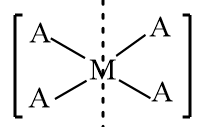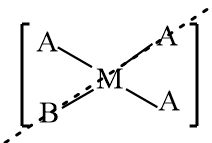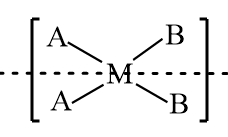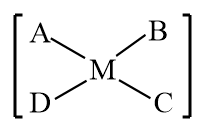
Answer
374.4k+ views
Hint: Optical isomerism: The compounds which have the same molecular and structural formula but cannot be superimposed on each other are known as optical isomers. The phenomenon is known as optical isomerism. In simple words, these compounds are non-superimposable mirror images of each other i.e. There must be no element of symmetry in a compound to show the optical isomerism.
Complete answer: In square planar complexes, a central atom is surrounded by four constituent atoms form corners of the square in the same plane. The coordination number of the central atom for the square planar complex is $4$.
Different types of square planar complexes are as follows:
$[M{A_4}]$: The structure is represented as follows:

As in the given structure, all four constituent groups connected to the central atom are the same, so it is an achiral molecule and the structure consists of a plane of symmetry, therefore it is an optically inactive compound.
$[M{A_3}B]$: The structure is represented as follows:

As in the given structure, three constituent groups connected to the central atom are the same, so it is an achiral molecule and the structure consists of a plane of symmetry, therefore it is an optically inactive compound.
$[M{A_2}{B_2}]$: The structure is represented as follows:

As in the given structure, two constituent groups connected to the central atom are the same, so it is an achiral molecule and the structure consists of a plane of symmetry, therefore it is an optically inactive compound.
$[MABCD]$: The structure is represented as follows:

Although the molecule consists of four different constituent groups, but a molecule is achiral when a rotation which is a combination of a rotation and a reflection in a plane, results in the formation of the same molecule, due to which the compound or molecule will be optically inactive. Therefore, it is also an optically inactive molecule.
Hence, Square planar complexes do not show optical isomerism because optical isomerism in structures is due to the absence of elements of symmetry but all the structures of square planar complexes possess the element of symmetry.
Therefore, option (A) is the correct answer.
Note:
It is important to note that as all the constituent groups in the square planar complex are present in the same plane, therefore these complexes can show geometrical isomerism i.e., the arrangement of groups can be compared for these molecules. Total five geometrical isomers are possible for a square planar complex.
Complete answer: In square planar complexes, a central atom is surrounded by four constituent atoms form corners of the square in the same plane. The coordination number of the central atom for the square planar complex is $4$.
Different types of square planar complexes are as follows:
$[M{A_4}]$: The structure is represented as follows:

As in the given structure, all four constituent groups connected to the central atom are the same, so it is an achiral molecule and the structure consists of a plane of symmetry, therefore it is an optically inactive compound.
$[M{A_3}B]$: The structure is represented as follows:

As in the given structure, three constituent groups connected to the central atom are the same, so it is an achiral molecule and the structure consists of a plane of symmetry, therefore it is an optically inactive compound.
$[M{A_2}{B_2}]$: The structure is represented as follows:

As in the given structure, two constituent groups connected to the central atom are the same, so it is an achiral molecule and the structure consists of a plane of symmetry, therefore it is an optically inactive compound.
$[MABCD]$: The structure is represented as follows:

Although the molecule consists of four different constituent groups, but a molecule is achiral when a rotation which is a combination of a rotation and a reflection in a plane, results in the formation of the same molecule, due to which the compound or molecule will be optically inactive. Therefore, it is also an optically inactive molecule.
Hence, Square planar complexes do not show optical isomerism because optical isomerism in structures is due to the absence of elements of symmetry but all the structures of square planar complexes possess the element of symmetry.
Therefore, option (A) is the correct answer.
Note:
It is important to note that as all the constituent groups in the square planar complex are present in the same plane, therefore these complexes can show geometrical isomerism i.e., the arrangement of groups can be compared for these molecules. Total five geometrical isomers are possible for a square planar complex.
Recently Updated Pages
what is the correct chronological order of the following class 10 social science CBSE

Which of the following was not the actual cause for class 10 social science CBSE

Which of the following statements is not correct A class 10 social science CBSE

Which of the following leaders was not present in the class 10 social science CBSE

Garampani Sanctuary is located at A Diphu Assam B Gangtok class 10 social science CBSE

Which one of the following places is not covered by class 10 social science CBSE

Trending doubts
Harsha Charita was written by A Kalidasa B Vishakhadatta class 7 social science CBSE

Which are the Top 10 Largest Countries of the World?

Banabhatta wrote Harshavardhanas biography What is class 6 social science CBSE

Difference Between Plant Cell and Animal Cell

Fill the blanks with the suitable prepositions 1 The class 9 english CBSE

How do you graph the function fx 4x class 9 maths CBSE

The Equation xxx + 2 is Satisfied when x is Equal to Class 10 Maths

One Metric ton is equal to kg A 10000 B 1000 C 100 class 11 physics CBSE

Why is there a time difference of about 5 hours between class 10 social science CBSE



